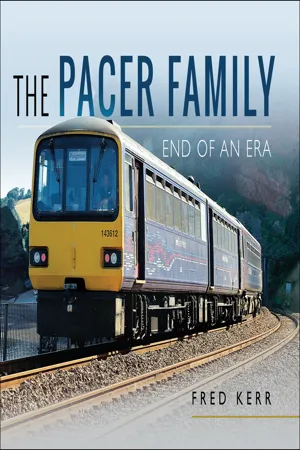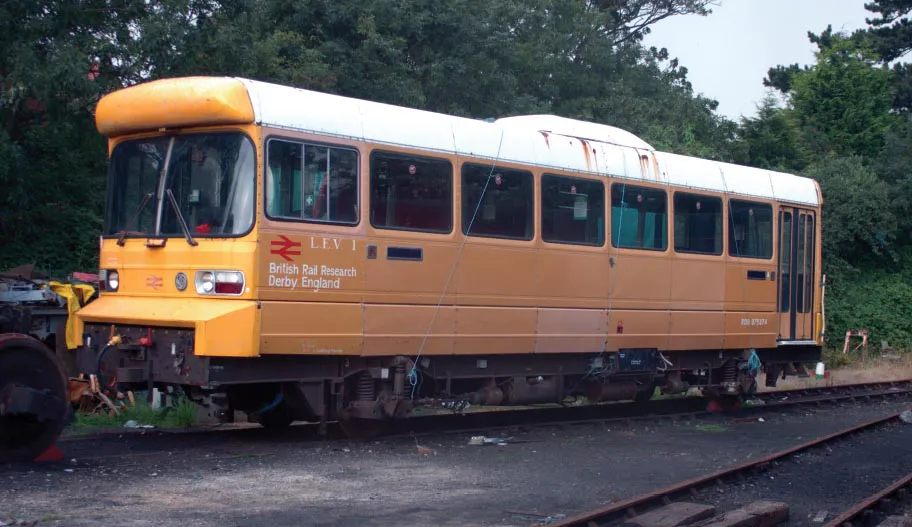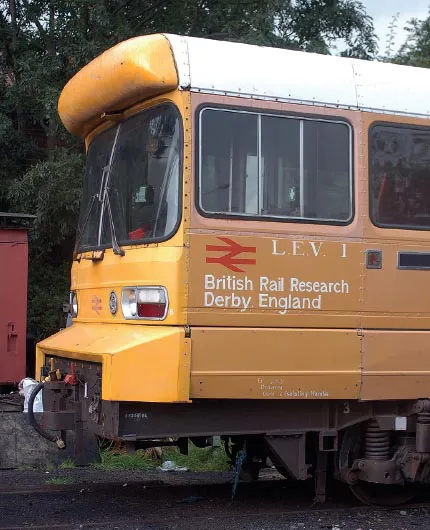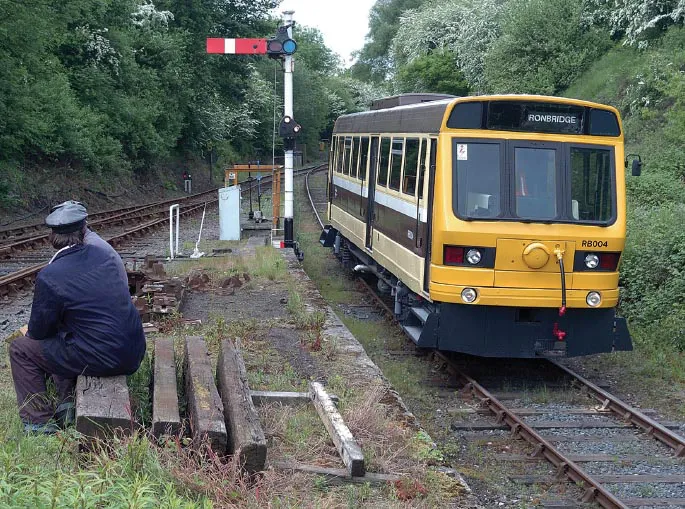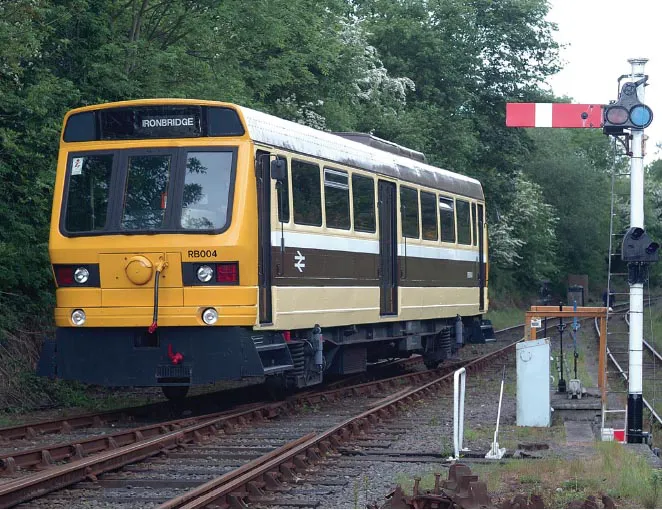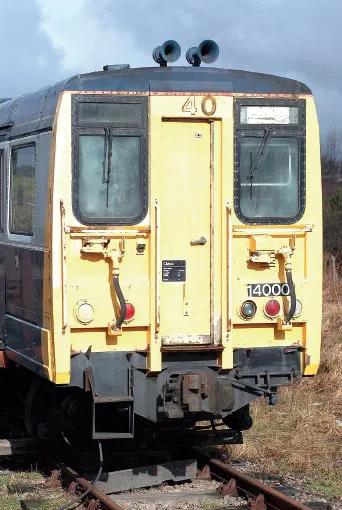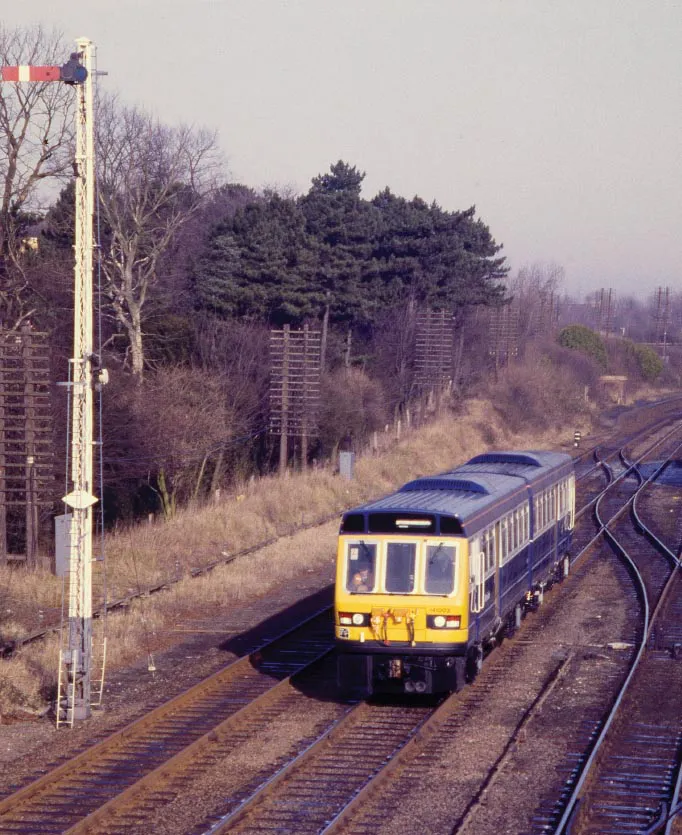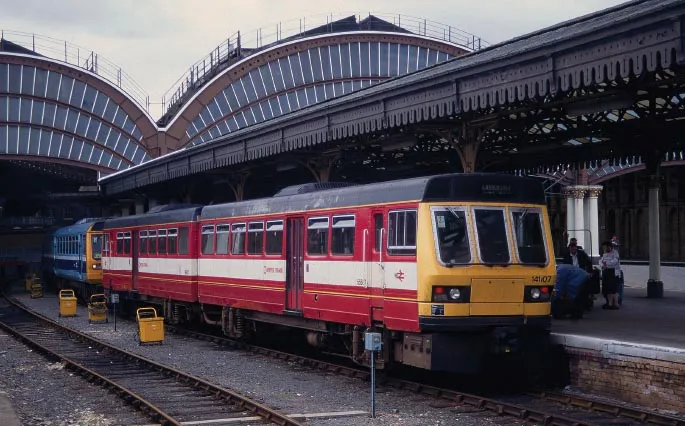![]()
Section 1:
Prototype Vehicles
1.1: LEV1 – Leyland Evaluation Vehicle 1
The venture began in 1977 when BR’s Derby-based Research Centre and British Leyland joined forces to investigate lightweight vehicle technology, based on the combination of a BR 2-axle chassis supporting a Leyland National bus-body. The Leyland vehicle was chosen because it was produced in modular form by a modern plant at Workington thus allowing vehicles of different length to be provided.
Initially the vehicle was unpowered and was towed at speeds of up to 80 mph coupled between two coaches in order to check ride quality, suspension performance and internal noise levels. The tests began in June 1978 and ran on the WCML to Carlisle following which the vehicle returned to Derby for the fitment of a drive train. The vehicle became identified as Leyland Evaluation Vehicle No 1 (LEV1), bearing Departmental number of RDB 975874, with a drive train comprising an under-floor Leyland 510 engine (rated at 200 hp/152 kW) coupled to a Self Changing Gears (SCG) mechanical gearbox. At the same time, LEV1 was fitted with a bulbous fairing above the cab windows, removal of doors at one end of the unit and the fitting of mesh grilles to the bus-type windscreens.
The vehicle was released for trails in June 1980, with a break for a visit to the USA in 1980 for evaluation, and when they were completed its importance to Railbus development led to it entering preservation with the National Rail Museum (NRM); after a period of storage it moved to the North Norfolk Railway in June 2004 on longterm loan and where its restoration to working order began; in 2012 it was moved to Shildon where, as at December 2016 it is on display.
A close-up view of the bulbous front addition above the cab windscreen and the coupling surround.
LEV1 stands in Sheringham station yard on 16 August 2004 whilst awaiting a start to its lengthy restoration to working order.
1.2: LEV2 – Leyland Evaluation Vehicle 2
LEV2 was produced in response to an order from the USA Department of Transportation following the visit of LEV1. It used a chassis assembled by D. Wickham & Company, based in Ware, and was fitted with a Leyland 690 engine rated at 220 hp. It was completed in August 1981 and, following trials on the Old Dalby test track, was shipped to the USA where it formed part of that country’s energy efficiency programme initiated by then President Jimmy Carter.
Following an accident in which the vehicle’s light weight – and consequent inability to activate the signalling systems of some companies – came under scrutiny, the trial was abandoned and the vehicle passed into ‘preservation’ during 1986 since when it has passed through many ownerships. As at December 2016 the vehicle is in the custody of the Connecticut Trolley Museum.
1.3: RB002 – Railbus 002
In 1984 Derby built a single vehicle as a demonstrator which was based on the Class 141 design that had recently been ordered. Initially sent to Denmark in May 1984 it continued onto Sweden before returning to the UK under its own power, including being displayed in Essen (Germany) and Bruges (Belgium) during June 1985. On its return it was modified to Canadian Railway specifications and sent there as a demonstrator; no orders were forthcoming and the vehicle returned to the UK during 1992 and subsequently languished as ‘office accommodation’ until bought by an Irish millionaire in 1999. The proposed line which it was bought to operate on seems to have been abandoned and, as at December 2016, the vehicle languishes and deteriorates at the site in Riverside Mills adjacent to the Dundalk–Greenore road.
1.4: RB003 – Railbus 003
RB003 was a further stage of development powered by a Leyland T11 engine driven through an SCG R14 gearbox but it still remained conceptually as a single vehicle with no consideration of multiple operation; its basic drawgear was fitted only to allow for haulage in cases of failure. The vehicle was released as an exhibit at the International Union of Public Transport exhibition in Dublin in May 1981 before returning to the UK for further trials at the Old Dalby test track.
The initial trials with BR began on the Western Region in October 1981 but continued on the freight-only Pye Bridge–Worksop line during 1982, during which time it received the Departmental number RDB 977020. In 1982 it was sold to Northern Ireland Railways (NIR) hence requiring re-gauging to the NIR 5 ft 3 in gauge. It was used on the Portrush–Coleraine branch line but criticisms of its poor riding qualities – especially over jointed track – and its inability to cope with increasing demand saw it being withdrawn from service in 1990. It was initially displayed in the Ulster Folk & Transport Museum in Cultra before being moved to the Downpatrick & County Down Railway where it is still located as at December 2016.
1.5: RB004 – Railbus 004
In addition to the RB002 Railbus, Derby produced a version that was moved to the USA in July 1984. After spending two months on trial with the Old Colonial Railroad in Newport it toured railways in both the USA and Canada before returning to the UK during 1986. It moved from Derby Works to ABB Yorks Works for use as a static office. It was sold to the Embsay & Bolton Abbey Railway in August 1994 for restoration but it subsequently passed through many ownerships until being bought by the Railbus Trust in 2011. As at December 2016 the vehicle is based at the Waverley Route Heritage Centre where it provides the site’s shuttle service.
1.6: Class 140
While the single Railbus vehicles were being trialled, the BR Business Sectors were sufficiently impressed to consider a 2-car trainset, using the Railbus technology, to cater for services on rural and branch lines, hence funding was provided to build the 2-car trainset that later became designated Class 140. The 2-car trainset was greatly modified from the single vehicle concept with the inclusion of a gangway connection and non-standard cab-ends that met current end-loading requirements; the result was a heavier vehicle at greater cost which moved further away from, rather than nearer to, the lightweight vehicle concept.
The trainset was released to service in 1981 with early trials taking place on routes within the West Yorkshire Passenger Transport Executive (WYPTE) area – centred on Leeds – but was later trialled around the country until returning to Neville Hill depot where it found use as a driver training vehicle. It was sold into preservation with the Keith & Dufftown Railway in 1994 and, as at December 2016, it is slowly being restored to operational use.
RB004 works the shuttle service at the Telford Steam Railway, based in Horsehay, on 28 May 2006.
140001 finds use as a exhibit at Dufftown (Keith & Dufftown Railway) on 7 March 2004 whilst awaiting restoration to working order.
![]()
Section 2:
Class 141
The first order for a ‘Pacer’ trainset came from BR in 1984 with an order for twenty 2-car units sponsored by the West Yorkshire Passenger Transport Executive (WYPTE) numbered 141.001–020. They were initially operated in WYPTE’s Verona Green and Buttermilk livery but, following the introduction of later classes 142–144 with different coupling arrangements, the new coupling was retrofitted when the trainsets were modified by Hunslet-Barclay during 1988–89. At the same time they were renumbered to 141.1xx and re-liveried in WYPTE’s then current Red and Cream livery with Metro branding.
This class of ‘Pacer’ trainset proved troublesome to operate and all trainsets were withdrawn by 1997 when later Class 14x variants became available. Surprisingly 14 units were exported, with 12 being sold to Iran and 2 to the Netherlands, but 4 trainsets (141103/08/10/13) entered preservation within the UK and, as at December 2016, can still be seen at work on heritage lines.
The units were initially operated on Leeds–Harrogate–York services as on 29 March 1986 when 141008 was noted passing Poppleton on a York–Leeds service bearing original WYPTE Verona Green and Buttermilk livery.
The early trainsets had their bodies delivered from Leyland’s Workington plant in Workington Blue livery which was retained whilst the trainset was being built. On 29 January 1984 trainset 141002 bears the blue livery as it passes Corby North whilst on its Derby CW–Bedford Acceptance Run.
141107 awaits departure from York on ...
